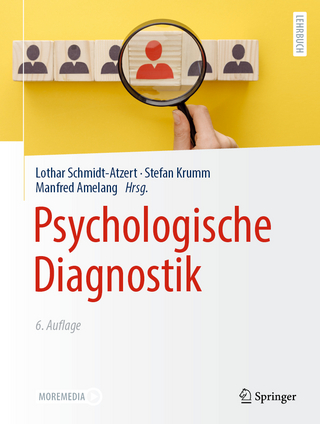
Success at Statistics
Pyrczak Publishing (Verlag)
978-1-884585-81-4 (ISBN)
- Titel erscheint in neuer Auflage
- Artikel merken
• Divided into 67 short sections, this book makes the topics easy to digest. Students regularly get positive reinforcement as they check their mastery with exercises at the end of each section.
• Each exercise is based on a humorous riddle. If the answer to a riddle makes sense, students know all their answers for that exercise are correct. If not, they know they need to check their answers.
• Short sections make it easy to customize your course by assigning only those sections needed to fulfill your objectives.
• A comprehensive basic math review at the end of this book may be used to help students whose math skills are rusty.
• Thoroughly field-tested for student interest and comprehension. The short sections and humor-based, self-checking riddles are greatly appreciated by students.
• Contains Part D on effect size, which provides technical solutions to issues raised in Part C (such as the limitations of inferential statistics).
Part A: Descriptive Statistics
1. Why is the Study of Statistics Important?
2. Descriptive Versus Inferential Statistics
3. Scales of Measurement
4. Frequencies, Percentages, and Proportions
5. Introduction to Frequency Distributions
6. Frequency Distribution for Grouped Data
7. Cumulative Frequencies, Cumulative Percentages, and Percentile Ranks
8. Histograms
9. Frequency Polygons
10. Shapes of Distributions
11. Introduction to Summation
12. The Mean: An Average
13. Mean, Median, and Mode
14. Variability: The Range and Interquartile Range
15. Variability: Introduction to the Standard Deviation
16. A Closer Look at the Standard Deviation
17. Another Look at the Standard Deviation
18. Standard Scores
19. Transformed Standard Scores
20. Standard Scores and the Normal Curve
21. Conceptual Introduction to Correlation
22. Scattergrams
Part B: Inferential Statistics
23. Introduction to Sampling
24. A Closer Look at Sampling
25. Introduction to Probability
26. Probability and the Normal Curve
27. Percentiles and the Normal Curve
28. Standard Error of the Mean
29. Confidence Interval for the Mean
30. Appropriate Figures
31. Introduction to the Null Hypothesis
32. Decisions About the Null Hypothesis
33. Introduction to the Pearson r
34. Computation of the Pearson r
35. Significance of a Pearson r
36. Coefficient of Determination
37. Multiple Correlation
38. Introduction to Linear Regression
39. Computations for Linear Regression
40. z Test for One Sample
41. When to Reject the Null Hypothesis
42. One-Tailed Versus Two-Tailed Tests
43. Introduction to the HSD Test
44. Computation of t for Independent Data
45. Reporting the Results of t Tests
46. Computation of t for Dependent Data
47. Introduction to Analysis of Variance
48. Computations for a One-Way ANOVA
49. Tukey’s HSD Test
50. Scheffé’s Test
51. Introduction to Two-Way ANOVA
52. Significance of the Difference Between Variances
53. Introduction to Chi-Square
54. Computations for a One-Way Chi-Square
55. Computations for a Two-Way Chi-Square
56. Cramér’s Phi
57. Median Test
58. Mann-Whitney U Test
59. Wilcoxon’s Matched-Pairs Test
Part C: Putting It All Together
60. Descriptive Statistics: Their Value in Research
61. Inferential Statistics: Their Value in Research
62. Limitations of Inferential Statistics: I
63. Limitations of Inferential Statistics: II
64. Statistical Versus Practical Significance
Part D: Effect
65. Introduction to Effect Size (d)
66. Interpretation of Effect Size (d)
67. Effect Size and Correlation (r)
Part E: Supplement
Basic Math Review for Statistics Students
Appendices
A. Computational Formulas for the Standard Deviation
B. Notes on Interpreting the Pearson r
C. Definition Formula for the Pearson r
D. Spearman’s rho
E. Standard Error of Estimate
F. Standard Error of a Median and a Percentage
G. Confidence Interval for the Mean: Small Samples
H. Computation of the Precise Median
I. A Closer Look At Effect Size
J. Summary of Statistical Equations
Tables
1. Table of the Normal Curve
2. Table of Random Numbers
3. Constants Based on t for Computing Confidence Intervals for the Mean Based on Small Samples
4. Critical Values of t for Two-Tailed t Test
5. Critical Values of t for One-Tailed t Test
6. Critical Values of F for the .05 Level
7. Critical Values of F for the .01 Level
8. Studentized Range Statistic (q) for the .05 Level
9. Studentized Range Statistic (q) for the .01 Level
10. Minimum Values for Significance of a Pearson r
11. Critical Values of Chi-Square
12. Critical Values of U for the .05 Level
13. Critical Values of U for the .01 Level
14. Critical Values of T for Wilcoxon’s Matched-Pairs Test
Index
| Erscheint lt. Verlag | 1.1.2009 |
|---|---|
| Verlagsort | Los Angeles |
| Sprache | englisch |
| Themenwelt | Geisteswissenschaften ► Psychologie |
| ISBN-10 | 1-884585-81-7 / 1884585817 |
| ISBN-13 | 978-1-884585-81-4 / 9781884585814 |
| Zustand | Neuware |
| Informationen gemäß Produktsicherheitsverordnung (GPSR) | |
| Haben Sie eine Frage zum Produkt? |
aus dem Bereich



